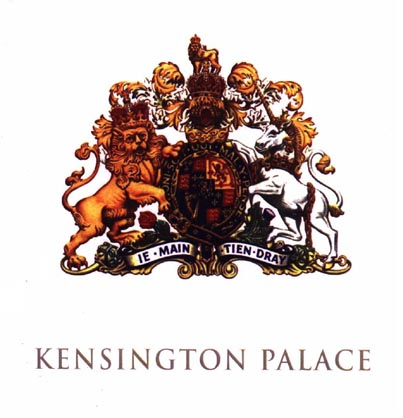
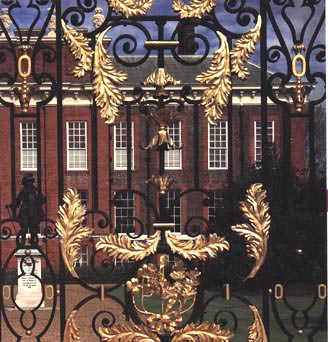
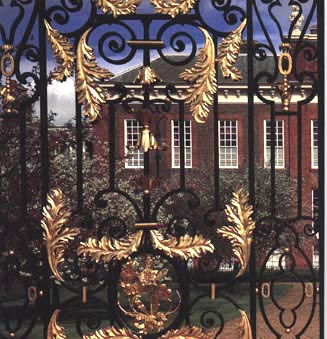
. |
  |

A Regal Invitation to Kensington Palace

You have just received the rare opportunity to become one of the first non-royals in U.K. history to host a night at Kensington Palace, a British Crown Royal Residence.
Beyond what money, power or fame can buy... Imagine the ultimate opportunity to create your own private evening at London's historic State Apartments, former home to Princess Diana, courtesy of The People's Princess Charitable Foundation, Inc.
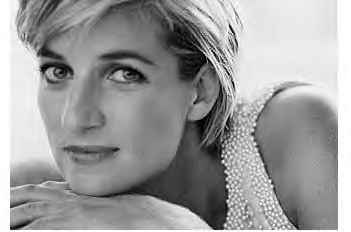 Whether you wish to create the most opulent dinner party for up to 170 guests, spoil 10 of your closest friends, or whisk away your beloved for the most sublimely captivating night for two, this rare enchanted evening will undoubtedly become one of the most magical ever. This exclusive, once-in-a-lifetime experience can be yours with 100% of the proceeds benefiting charity!
Whether you wish to create the most opulent dinner party for up to 170 guests, spoil 10 of your closest friends, or whisk away your beloved for the most sublimely captivating night for two, this rare enchanted evening will undoubtedly become one of the most magical ever. This exclusive, once-in-a-lifetime experience can be yours with 100% of the proceeds benefiting charity!
 Following the storybook wedding of Lady Diana Spencer to Prince Charles in 1981, the late Princess Diana became the most celebrated model of British clothing since Jean Shrimpton and Twiggy. She commissioned scores of elegant dresses by designers such as Catherine Walker and Victor Edelstein, wearing them at events that ranged from London movie premieres to official tours of the Commonwealth. Yet without question, Princess Diana won the hearts of the world through her humanitarian projects.
Following the storybook wedding of Lady Diana Spencer to Prince Charles in 1981, the late Princess Diana became the most celebrated model of British clothing since Jean Shrimpton and Twiggy. She commissioned scores of elegant dresses by designers such as Catherine Walker and Victor Edelstein, wearing them at events that ranged from London movie premieres to official tours of the Commonwealth. Yet without question, Princess Diana won the hearts of the world through her humanitarian projects.
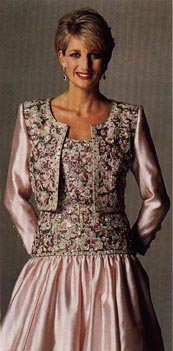 In 1997, just months prior to her death, Princess Diana had a number of items in her royal dress collection auctioned by world-famous Christie's to raise money for her favorite humanitarian causes. Fourteen of the dresses were anonymously acquired by a philanthropist from Florida.
In 1997, just months prior to her death, Princess Diana had a number of items in her royal dress collection auctioned by world-famous Christie's to raise money for her favorite humanitarian causes. Fourteen of the dresses were anonymously acquired by a philanthropist from Florida.
 It is often said that to whom much is given, much is expected. What originated with the purchase of the collection of a Princess led to the creation of The People's Princess Charitable Foundation, Inc. (TPPCFI). Continuing the model of humanitarian action, the dedicated mission of TPPCFI is “to acquire, maintain, preserve, and display to the public items of historical and cultural interest relating to Diana, the Princess of Wales,” and “to conduct, both directly and through grants to other charitable organizations, activities in furtherance of the charitable and educational purposes supported or endorsed by the late Diana, Princess of Wales, during her lifetime… including but not limited to the prevention, treatment, cure, and alleviation of suffering from AIDS and related disorders, cancer, injuries caused by land mines, and the provision of care and services for disadvantaged children.” Through this multi-faceted platform of humanitarian work, the dream ... of a Princess lives on.
It is often said that to whom much is given, much is expected. What originated with the purchase of the collection of a Princess led to the creation of The People's Princess Charitable Foundation, Inc. (TPPCFI). Continuing the model of humanitarian action, the dedicated mission of TPPCFI is “to acquire, maintain, preserve, and display to the public items of historical and cultural interest relating to Diana, the Princess of Wales,” and “to conduct, both directly and through grants to other charitable organizations, activities in furtherance of the charitable and educational purposes supported or endorsed by the late Diana, Princess of Wales, during her lifetime… including but not limited to the prevention, treatment, cure, and alleviation of suffering from AIDS and related disorders, cancer, injuries caused by land mines, and the provision of care and services for disadvantaged children.” Through this multi-faceted platform of humanitarian work, the dream ... of a Princess lives on.

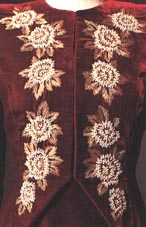 From October 1997 to June 2001, under the guidance of the Smithsonian Institution and as part of a professionally curated, 5,600 square foot, “Dresses for Humanity," an exhibition of the dresses of the Princess of Wales traveled the globe with the proceeds benefiting various charities along the exhibition tour. At the end of the tour and with the direct approval of Her Majesty Queen Elizabeth II and HRH Prince Charles, the dresses were “put to rest” at Kensington Palace, the former home of the late Princess Diana, for the enjoyment and education of the public, as well as for the proximity to her two sons. The dresses are currently part of the Royal Ceremonial Dress Collection with the dollars generated by ticket sales used for the preservation of Kensington Palace until such time as they are returned to the Foundation.
From October 1997 to June 2001, under the guidance of the Smithsonian Institution and as part of a professionally curated, 5,600 square foot, “Dresses for Humanity," an exhibition of the dresses of the Princess of Wales traveled the globe with the proceeds benefiting various charities along the exhibition tour. At the end of the tour and with the direct approval of Her Majesty Queen Elizabeth II and HRH Prince Charles, the dresses were “put to rest” at Kensington Palace, the former home of the late Princess Diana, for the enjoyment and education of the public, as well as for the proximity to her two sons. The dresses are currently part of the Royal Ceremonial Dress Collection with the dollars generated by ticket sales used for the preservation of Kensington Palace until such time as they are returned to the Foundation.
Kensington Palace History
 As the former residence of Princess Diana, and of great historical importance, Kensington Palace dates back to the early 1600s, when it was originally a country house belonging to the Earl of Nottingham. As one of several mansions in the village of Kensington, Nottingham House was purchased in 1689 by King William III, who hired renowned architect Christopher Wren to expand it into the Palace that exists today. This included the construction of the Royal Apartments for the King and Queen, a Council Chamber, the Chapel Royal and the Great Stairs. A private road, part of which survives today as Rotten Row, was laid out from the Palace to Hyde Park Corner, wide enough for three or four carriages to travel abreast down it. Until the death of King George II in 1760, Kensington Palace was the favorite residence of successive sovereigns.
As the former residence of Princess Diana, and of great historical importance, Kensington Palace dates back to the early 1600s, when it was originally a country house belonging to the Earl of Nottingham. As one of several mansions in the village of Kensington, Nottingham House was purchased in 1689 by King William III, who hired renowned architect Christopher Wren to expand it into the Palace that exists today. This included the construction of the Royal Apartments for the King and Queen, a Council Chamber, the Chapel Royal and the Great Stairs. A private road, part of which survives today as Rotten Row, was laid out from the Palace to Hyde Park Corner, wide enough for three or four carriages to travel abreast down it. Until the death of King George II in 1760, Kensington Palace was the favorite residence of successive sovereigns.
Queen Victoria was born and brought up in the Palace. It was here in 1837 that a young Victoria was awakened with the news from the Lord Chamberlain and the Archbishop of Canterbury that her uncle, King William IV, had died and she was now the Queen of England. It had been expected that Queen Victoria would reign from either Kensington or St. James' Palace, but she relocated to Buckingham Palace almost immediately and never again stayed at Kensington.
Queen Mary (grandmother of the present Queen) was also born at Kensington Palace in 1867. The Duke of Edinburgh stayed there in his grandmother's apartment in 1947 between his engagement and his marriage. Both Princess Margaret and Princess Alice once lived at Kensington Palace and had their offices there. However, Kensington's best known resident in recent years was Diana, Princess of Wales (1961-97) and her two sons, William and Harry, who occupied the State Apartments in the northwest part of the Palace from 1981 to 1997.
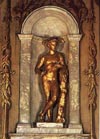 Kensington Palace was first opened to the public in 1912 with a display of relics and objects relating to the City of London. Today it is a true working royal residence and contains the offices and London residences of The Duke and Duchess of Gloucester, The Duke and Duchess of Kent, and Prince and Princess of Kent. Kensington Palace is also home to the Royal Ceremonial Dress Collection, which includes the Princess Diana Dress Collection along with other items of Royal, ceremonial and court dress dating from the 18th century to the present day. Historic parts of Kensington Palace are open to the public for tours during the day while in the evening, the Palace is reserved for members of the royal family and select private events.
Kensington Palace was first opened to the public in 1912 with a display of relics and objects relating to the City of London. Today it is a true working royal residence and contains the offices and London residences of The Duke and Duchess of Gloucester, The Duke and Duchess of Kent, and Prince and Princess of Kent. Kensington Palace is also home to the Royal Ceremonial Dress Collection, which includes the Princess Diana Dress Collection along with other items of Royal, ceremonial and court dress dating from the 18th century to the present day. Historic parts of Kensington Palace are open to the public for tours during the day while in the evening, the Palace is reserved for members of the royal family and select private events.
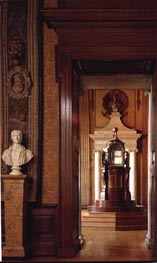 The State Apartments - Diana's Former Home
The State Apartments - Diana's Former Home
In appreciation of the Historical Royal Palaces' long-term use of the Princess Diana Dress Collection, access to a number of the historical rooms within the State Apartments has been granted to The People's Princess Charitable Foundation, Inc. to assist with its fund raising initiative. As part of that exclusive offering, select rooms that are typically unavailable to non-royals and only available to the highest ranking members of the British Royal Family may be utilized for private dinners and/or parties. These historic rooms include:
The Cupola Room - Available for Dinner or Cocktails
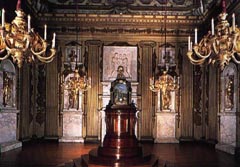 As the principal stateroom of the Palace, it was here that the young Princess Victoria (later Queen Victoria) was christened by the Archbishop of Canterbury in 1819.
As the principal stateroom of the Palace, it was here that the young Princess Victoria (later Queen Victoria) was christened by the Archbishop of Canterbury in 1819.  The lavish decoration in this room was executed by William Kent but only after a fierce argument with the King's Principal Painter, Sir James Thornhill. By rights, Thornhill should. have been given the work but Kent undercut his rival and was awarded the commission in 1722. Thornhill's distinguished design scheme makes extensive use of trompe l'oeil. The ceiling is painted with octagonal coffers (ornamental sunken panels) in blue and gold, diminished in size towards the top to give an optical illusion of height. Furnishings in this room include a magnificent 18th-century musical clock that once played tunes by Handel, Corelli and Geminiani and an impressive bas-relief by Michael Rysbrack depicting a Roman marriage.
The lavish decoration in this room was executed by William Kent but only after a fierce argument with the King's Principal Painter, Sir James Thornhill. By rights, Thornhill should. have been given the work but Kent undercut his rival and was awarded the commission in 1722. Thornhill's distinguished design scheme makes extensive use of trompe l'oeil. The ceiling is painted with octagonal coffers (ornamental sunken panels) in blue and gold, diminished in size towards the top to give an optical illusion of height. Furnishings in this room include a magnificent 18th-century musical clock that once played tunes by Handel, Corelli and Geminiani and an impressive bas-relief by Michael Rysbrack depicting a Roman marriage.
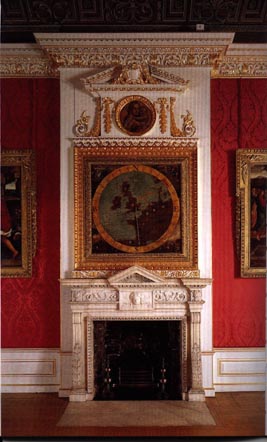 The King's Drawing Room - Available for Dinner
The King's Drawing Room - Available for Dinner
The Drawing Room was the focal point of court life where, on public days, the king would meet members of the court, dressed in their finery. The assembly became known as a 'Drawing Room,' and these public days at court were frequently held on Thursdays and Sundays when the royal family also dined in public.
William Kent was responsible for the original furnishing and decoration of the room but, unfortunately, little of his work survives, with the exception of the impressive chimneypiece and the painted ceiling, which shows Jupiter appearing to his lover, Semele, who he inadvertently destroyed with his divine power. Like the Cupola Room, the King's Drawing Room was lit by four carved, gilt chandeliers made by Gumley and Moore. The furniture was also probably supplied by Gumley and Moore.
The room is hung with mainly 17th-century paintings including two by Benedetto Gennari painted for King Charles II in 1676. Opposite the fireplace is Venus and Cupid by Giorgio Vasari (1511-74) after Michelangelo, which King George II referred to as his 'fat Venus.' The over door portraits of Venetian Dogs are by Odoardo Fialetti and were acquired by Sir Henry Wotton, a former ambassador to Venice, and bequeathed by him to Charles I.
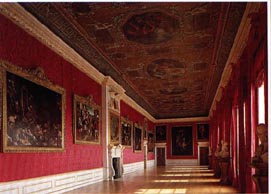 The King's Gallery was built for King William III in 1695 and was intended as a gallery for some of the finest portraits in the Royal Collection - a function it still serves today.
The King's Gallery was built for King William III in 1695 and was intended as a gallery for some of the finest portraits in the Royal Collection - a function it still serves today.
In November 1700 the London Gazette reported that the King had returned from Hampton Court to celebrate his birthday at Kensington, where there were 'Entertainments for the Ladies, and other Persons of Quality in the Great Gallery.' It was also here on March 3, 1702, that King William was taken ill, a few days after his riding accident at Hampton Court. The King died five days later, on March 8, 1702, at age 51.
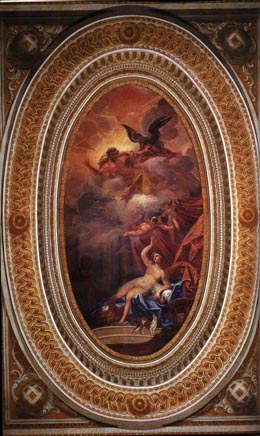 The King's Gallery has been refurbished following the decorative scheme devised for King George I. In 1725, the King commissioned William Kent to design and decorate a new gallery, which had to incorporate the carved cornice and other decorative features designed for King William III. The remarkable wind dial above the chimneypiece, for example, was made for King William by Robert Morden in 1694, but Kent was asked to design a new marble chimneypiece and a carved overmantel around it. The points of the compass are marked round the circumference of a map of northwestern Europe and the direction of the prevailing wind is indicated by the pointer operated by rods connected to a wind vane on the roof. In the corners are painted scenes, probably by Robert Robinson, illustrating the four continents (Australia was not discovered until the late 18th century).
The King's Gallery has been refurbished following the decorative scheme devised for King George I. In 1725, the King commissioned William Kent to design and decorate a new gallery, which had to incorporate the carved cornice and other decorative features designed for King William III. The remarkable wind dial above the chimneypiece, for example, was made for King William by Robert Morden in 1694, but Kent was asked to design a new marble chimneypiece and a carved overmantel around it. The points of the compass are marked round the circumference of a map of northwestern Europe and the direction of the prevailing wind is indicated by the pointer operated by rods connected to a wind vane on the roof. In the corners are painted scenes, probably by Robert Robinson, illustrating the four continents (Australia was not discovered until the late 18th century).
The art displayed in the gallery includes important masterpieces by Bassano, Bonifazio and Tintoretto that are known to have hung in the gallery during the reign of King George II. The ceiling paintings depict scenes from the story of Ulysses and were executed by William Kent and an assistant in 1725.
In 1835 the gallery was partitioned into three rooms for the Duchess of Kent and Princess Victoria. The young Princess described the new rooms in her Journal: 'The old gallery ... is portioned into three large, lofty, fine cheerful rooms. One only of these is ready furnished; it is my sitting-room and is very prettily furnished indeed ... The next is my study, and the last is an ante-room.' Traces of the patterned red wallpaper used in the Princess' sitting-room were discovered when the King's Gallery was restored in 1993-94.
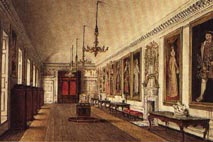 Although the present curtains are modern, when this gallery was first built, the paneled walls were hung with silk ‘the color chosen by the Queen with white damask curtains adorning the windows.' In the 1720s, the paneling was painted white under the direction of William Kent, and the paint was not stripped off again until the restoration of 1898-99.
Although the present curtains are modern, when this gallery was first built, the paneled walls were hung with silk ‘the color chosen by the Queen with white damask curtains adorning the windows.' In the 1720s, the paneling was painted white under the direction of William Kent, and the paint was not stripped off again until the restoration of 1898-99.
The large mahogany cabinet which stands against the north wall was originally made as an organ case for Queen Caroline in 1735 but was converted into a cabinet by William Vile in 1763 on the orders of Queen Charlotte. A concealed entrance in the paneling in the northwest corner of the room led to the apartments of the Maids of Honor.
The splendid full-length portrait of Peter the Great, Tsar of Russia, which hangs on the south wall was painted for King William III by Sir Godfrey Kneller during the Tsar's visit to London in 1698. The west wall is hung mainly with family portraits, including one of King William III and Queen Mary by William Wissing painted in 1685, and a portrait of Anne Hyde, Duchess of York, first wife of King James II and mother of Queen Mary painted by Sir Peter Lely circa 1662.
Reserve this rare opportunity to host your 2009 evening now! There are only a limited number of available dates this year not held in reserve for Palace or Royal Family use. Due to the exclusive nature of this invitation, we expect these dates will quickly be booked.

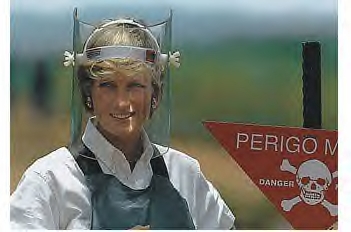 Charitable Deduction: As a bona fide 501c3 registered charity, the donation for the evening is 100% tax deductible through The People's Princess Charitable Foundation, Inc. where your dollars continue to serve the dream......of a Princess in support of her charitable causes, and humanitarian efforts around the world.
Charitable Deduction: As a bona fide 501c3 registered charity, the donation for the evening is 100% tax deductible through The People's Princess Charitable Foundation, Inc. where your dollars continue to serve the dream......of a Princess in support of her charitable causes, and humanitarian efforts around the world.
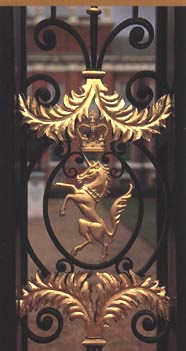 Dinner: Offering a superb menu selection, your uniquely private dinner may take place in either the magnificent King's Drawing Room which can accommodate up to 90 guests, the opulent Cupola Room which can accommodate 80, or both rooms may be utilized together for up to 170 guests. Alternatively, you may wish an intimate dinner party for your closest friends, or as the ultimate private dining experience for two as the most romantically intimate evening imaginable.
Dinner: Offering a superb menu selection, your uniquely private dinner may take place in either the magnificent King's Drawing Room which can accommodate up to 90 guests, the opulent Cupola Room which can accommodate 80, or both rooms may be utilized together for up to 170 guests. Alternatively, you may wish an intimate dinner party for your closest friends, or as the ultimate private dining experience for two as the most romantically intimate evening imaginable.
Cocktails: Available in the Cupola Room or surrounding the Princess Diana Dress Collection with close of evening champagne toast in the elegant Queen Mary's Gallery.
Entertainment: A selection of the most revered entertainment of your selection as approved by the Palace, or a private concert with select members of the London Symphony Orchestra is available for a cocktail reception in the King's Gallery.
Palace Tour: A private tour of Kensington Palace and the State Apartments including viewing of the acclaimed Princess Diana Dress Collection may also be arranged. Alongside the dress collection, a stunning new exhibit of Mario Testino's images originally taken for Vanity Fair magazine runs through July, 2007. Unknown at the time, these images were to be the last official portraits taken of Diana, Princess of Wales.
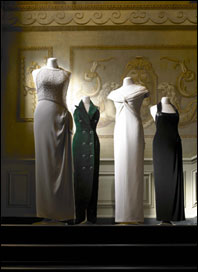 Weddings: Without question, the Palace is the perfect location for the ultimate, paparazzi-free, no fly zone, private celebrity wedding! It is the one place in the world that can literally guarantee a completely private event.
Weddings: Without question, the Palace is the perfect location for the ultimate, paparazzi-free, no fly zone, private celebrity wedding! It is the one place in the world that can literally guarantee a completely private event.
Charity Fundraisers: In support of your favorite charity, we can also develop a humanitarian event or fundraiser to be held at Kensington Palace.
Details: To download the Power Point presentation; or receive it as a PDF file, click Kensington Presentation; for the PDF Brochure; or to Reserve this rare one-of-a-kind experience, click the link.
For a sampling of ideas to consider for your evening at Kensington Palace, click the events or to download a basic map of the Palace and grounds, click the link.
 To reserve your special evening at Kensington, please contact the exclusive worldwide representative:
To reserve your special evening at Kensington, please contact the exclusive worldwide representative:
Ms. Kaya Morgan, Principal; or
Team Associates: Lucia Kaiser and Conrad Loreto
IMAGINE MediaWorks & Island Connections
9030 W. Sahara Ave., #236
Las Vegas, NV. 89117
Tel: 702.242.3247; Fax 702.240.2716
E-Mail: MediaLasVegas@aol.com

Download the latest issue of the London-based wealth advisors publication to read the interview with Kaya Morgan, click on: CityWealth or go directly to: http://www.jonespartnersconsulting.co.uk/Citywealth/Citywealth141105.pdf
Ol Malo: A brief power point presentation on the Ol Malo project in support of the Samburu tribe, Kenya, Africa, is available by clicking the link.
All rights reserved © 2009
Press Coverage | VentureCapital | Business Development | Venture Opportunities | Resources | Investor Extras | Home